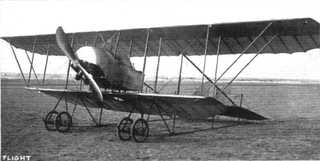Related Research Articles
The Ponnier M.1 was an early French World War I fighter aircraft Most of those produced were operated by the Aviation Militaire Belge. They were deemed unusable by the Belgian ace Willy Coppens and rapidly retired.
The Caudron C.251 Et-2 was a French tandem seat, open cockpit biplane designed as an intermediate trainer and built in 1931. It did not go into production.
The Caudron C.220 was a two-seat French biplane trainer. Only two were built, using different engines.

The Caudron C.27 was a French biplane, a two-seat basic trainer which also competed successfully in the 1920s.
The Caudron C.99 was a French light bomber and reconnaissance aircraft. The only example flew with different engines in the mid-1920s.

The Caudron C.101 and its variants, the C.103, C.104 and C.107 were French two seat reconnaissance aircraft flown from 1925, differing in their engines.

The Caudron C.43 was the first French five-engined aircraft, a biplane intended for passenger transport or military use and multi-engined for safety. A development of the three-engined Caudron C.39, it had one tractor configuration engine in the nose and two push-pull pairs between the wings. It was capable of carrying eight passengers but was not developed.
The Caudron C.37 was a French three-engined biplane passenger transport, built in 1920. It could carry six passengers.

The Caudron C.33 "Landaulet Monsieur-Madame" was a French twin engined biplane with four seats, two in open cockpits and two in an enclosed cabin.
The Caudron C.22 was a French twin engine night bomber built in 1917. It did not reach production.
The Caudron C.21 was a French twin engine biplane built just after World War I, able to carry three passengers in an open cockpit.

The Caudron Types M and N were small, fast French sports monoplanes, flown 1911–13 under a wide range of engine powers. There was also a military version.
The Caudron Type H was a collective name for three different Caudron designs of 1912-3. One of these was an amphibious three seat biplane built for the French military. Two were completed, one appearing at the Paris Aero Salon in November 1912.

The Caudron Type L was a two-seat French pusher configuration amphibious biplane, flown around 1913 and intended for naval use.
The Caudron Type B was a 1911 development of the earliest Caudron type, the Caudron Type A, with a nacelle style fuselage and more powerful engine. Initially an equal span biplane, it was modified into a sesquiplane.
The Caudron Type K was a French floatplane with a very powerful, twenty cylinder radial engine in pusher configuration. It took part in a French seaplane competition in 1913, but was lost in a take-off accident during the competition.
The Caudron Type C was a single seat French biplane, intended for military evaluation. Two were built in 1911.

The Caudron Type F was a French single seat biplane produced just before World War I. A dozen were bought by China and at least two other examples, with different engines, competed in 1913, coming first and second in the biplane category of the cross-country race at Reims. Flown by Pierre Chanteloup, one was the first biplane to loop-the-loop.

The Caudron Type D was a French pre-World War I single seat, twin-boom tractor biplane, a close but slightly smaller relative of the two seat Caudron Type C. More than a dozen were completed, one exported to the United Kingdom, where they may also have been licence built, and three to China.
The Caudron Type E two seat trainer was a larger and more powerful development of the Type C. Two or three were bought by the French military and one by the Royal Navy just before World War I but its sales were overtaken by the superior Type G.
References
- 1 2 3 4 5 6 7 8 9 10 Hauet, André (2001). Les Avions Caudrons. 1. Outreau: Lela Presse. p. 135. ISBN 2 914017-08-1.
- 1 2 3 4 Green, William; Swanborough, Gordon (1994). The Complete Book of Fighters. Godalming, UK: Salamander Books. p. 11. ISBN 1-85833-777-1.
- ↑ Hauet (2001). Les Avions Caudrons. p. 66.